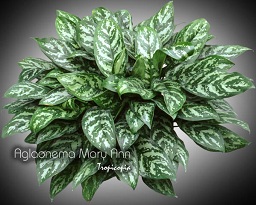Table of contents
Chinese Evergreen

Latin Name: Aglaonema ‘Mary Ann’
Category: Aglaonema
Family: Araceae
Origin: Hybrid
Climate: Tropical
Growing Zones: 11
Care Instructions
The Chinese Evergreen (Aglaonema ‘Mary Ann’) is a tropical plant that originates from Hybrid. This aglaonema plant belongs to the Araceae family and is well-suited for growing in USDA zones 11.
Complete Care Guide for Chinese Evergreen (Aglaonema ‘Mary Ann’)
Watering Requirements
The Chinese Evergreen, particularly the variety ‘Mary Ann’, thrives with moderate watering. It is essential to allow the top inch of soil to dry out between waterings to prevent root rot, which is a common issue with this plant. During the growing season, typically spring and summer, you should water the plant more frequently, about once a week, while in the dormant months of fall and winter, reduce watering to every two weeks. Always check the moisture level by inserting your finger into the soil; if it feels dry, it’s time to water. Additionally, using room temperature water is recommended to avoid shocking the plant.
Light Conditions
Chinese Evergreens prefer bright, indirect light but can also tolerate low-light conditions, making them ideal for indoor environments. Direct sunlight can scorch their leaves, so it’s best to place them near a window with filtered light or in a well-lit room. If the leaves start to lose their vibrant color or become leggy, it may be a sign that the plant is not receiving enough light. Conversely, if the leaves develop brown tips, it may indicate too much direct sunlight. A balance of light is crucial for maintaining the health and beauty of the ‘Mary Ann’ variety.
Soil Preferences
For optimal growth, the Chinese Evergreen ‘Mary Ann’ thrives in a well-draining potting mix. A blend of peat moss, perlite, and pine bark is ideal, as it retains moisture while allowing excess water to drain away. This plant prefers slightly acidic to neutral pH levels (around 6.0 to 7.0). Fertilization should be done during the growing season with a balanced, water-soluble fertilizer every 4-6 weeks. However, avoid over-fertilizing, as this can lead to salt buildup in the soil, which can harm the roots. In the fall and winter months, reduce or stop fertilization as the plant enters its dormant phase.
Pests and Diseases
Chinese Evergreens are generally resilient but can be susceptible to pests such as spider mites, mealybugs, and aphids. Regularly inspect the undersides of leaves and the stems for any signs of infestation. If you notice pests, treat them promptly with insecticidal soap or neem oil. Additionally, ensure good air circulation around the plant to prevent fungal diseases, which can occur in overly humid conditions. Yellowing leaves may indicate overwatering or root rot, while brown spots can be a sign of underwatering or sunburn. Addressing these issues quickly will help maintain the plant’s health.
Special Care Tips
To keep your Chinese Evergreen ‘Mary Ann’ thriving, consider the following special care tips: First, regularly wipe the leaves with a damp cloth to remove dust, which can hinder photosynthesis. This also allows you to check for pests more easily. Second, rotate the plant occasionally to ensure even growth, as it may lean towards the light source. Lastly, be cautious of cold drafts and sudden temperature changes, as this plant prefers a stable environment. If you notice any leaf drop, it may be a sign of stress from environmental changes. With these care tips, your Chinese Evergreen will flourish and add beauty to your indoor space.








